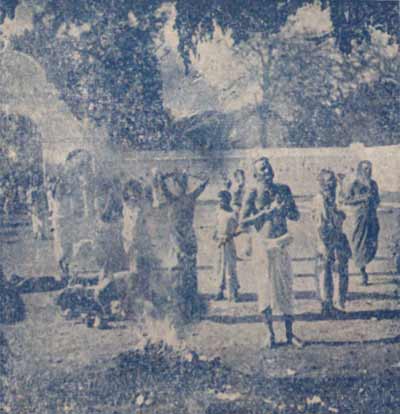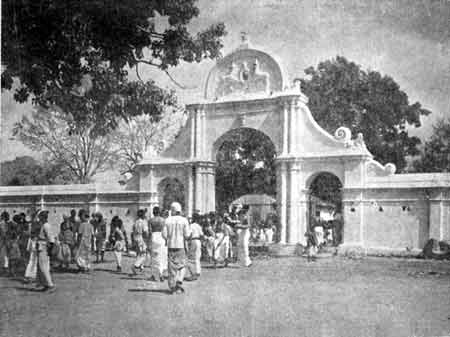|
| ||||||||||||||||
Kataragama – Memories of Sixty Years AgoWe from Kandy of long ago, sixty or more years back, were strangers to Kataragama. Of course we had heard about the devalé and all that but we did not undertake pilgrimages to this southern holy place. An annual reminder however, that the Kataragama festival was on, were the yellow clad sanyasis who would suddenly appear at the gate of our home in Katukelle, Kandy, with hair overgrown and matted, decked in bead chains and sometimes with a fork or short spear through one cheek and out the other. They were silently asking for money. I well remember the men with nails driven into their backs drawing a cart, the skin all pulled out. Small as I was I wondered who the god was who demanded such torture as homage. I remember as a tiny kid crying because Mother was not home. She had gone to Adam’s Peak and in those days it was a totally hazardous trip with no electric lights strung along the way, and hardly any boutiques and sustenance en route. Anuradhapura and Polonnaruwa were frequent pilgrimage destinations from early on since one could travel by train to them; car travel was also undertaken. As I remember we were more into Dalada Maligawa worship and once in a while paid pooja to the devales in close proximity to the Maligawa and even more infrequently to the Kataragama Kovil down Colombo Street, was it? Later with connections forged with families in Ratnapura we heard of their unfailing annual pilgrimage to Kataragama. Travel to Tissamaharama was by car, thereafter it was packing in to bullock carts for an overnight slow trek to the Devala, amidst elephant haunts. The jolting was so bad in the carts that the men and boys opted to trudge the thorny uneven eleven miles. It was a huge item of news when Sidney de Zoysa, the well known policeman, motored first on the newly constructed road to Kataragama, circa late 1940s. In 1952, a person from Kandy married to a Sabaragamuwa wife was coaxed to make a vow to cure himself of a skin eruption in his feet by walking from Tissa to Kataragama; which he did and was cured. Woolf’s civil service in Hambantota - 1910Reading Leonard Woolf’s Village in the Jungle (published 1913) was my strong introduction to this acknowledged haunt of God Skanda Murugan and his consort Valli Amma. Woolf does not mention the name per se but it is obvious Silindu, in the power of a devil, is made to take a vow and go on pilgrimage to Kataragama which Karlina, his sister, arranges, on the advice of the vedarala. "Well, it lies over there to the east, five days journey through the jungle, beyond Maha Porana and a River of Jewels. There is a great temple there, and the great Beragama deviyo lives in it. He is a Tamil god so they say, but Sinhalese kapurales serve him in the temple… His power is over the jungle and the devils who live in it…. You and the girls can take him there; and perhaps I will go too, for I have made a vow myself."
We had heard of the fire walking and weren’t we as giggly teenagers enthralled by the fact one of the Kandy Methodist Church young padres was to attempt fire walking at Kataragama. He went. He walked. And got burnt in the soles of his feet! And then we too started visiting Kataragama, more with a planter brother in Passara arranging a pilgrimage cum holiday at Hambantota when the resthouse was really classy and served the freshest fish and tastiest meals. Several visits were undertaken in the 1950s and 60s and thereafter until I felt I was happy to worship at the Kirivhera but had qualms about all the bargaining that went on with the Kataragama God for this and that blessing and benefit with offers of huge pooja vatti and much money and tiny silver figurines. There was far too much commercialism from the time pilgrims flocked to the place. Money was the chief consideration from the hoppers you bought from a woman seated on the ground making them to the pooja vatti seller. It was even acknowledged that the kapuralas who accepted the vattis noticed first the amount of hard cash placed in them. And so on one visit I decided to stay outside the devale while my family went in, not snaking along the long queue of vatti bearers but only offering money. I had tied up a cleaned coin in a small bit of cloth as Mother would do and asked that it be dropped in the till. And then as I stood there I felt wet on one shoulder. No rain. It was a monkey using me as his toilet! Was the God angry with me, I wondered with trepidation as I ran to the Menik Ganga to wash myself.
We did have superstitious beliefs: you never said you were planning or setting off on a trip to Kataragama. It was always ‘going South on pilgrimage’ or just ‘going South.’ Meals were strictly vegetarian – not even laced with Maldive fish - two days before you set off and until you had completed the pilgrimage. You avoided making a guesstimate of time of arrival. My brother once did this and assured mother he would take her for the morning pooja. His new car shuddered and stopped dead en route from Tissa to Kataragama necessitating a major repair. Mother and I accepted a kind lift offered and awaited my brother’s arrival at the Ramakrishna Mission. No mid-morning pooja for us! Now this was a place of delight; to stay over in or just have a meal or two. Rooms in the sprawling Ramakrishna Mission were small with mats to sleep on but toilets were kept very clean. Food was tasty, served on banana leaves spread on the ground as you squatted down awaiting the food buckets on wheels; first fluffy steaming rice, then sambar with dhall and murunga and other vegetables and the ground, orange sambal. A squat Hindu religious man oversaw the meals, yellow robed and perching himself on the half wall in the meal area. His assistant was a very tall, well built, handsome Tamil in a white verti with chest and forehead striped with white ash. They charged nothing for meals, but most gave donations and paid for rooms used as they thought fit. Great alms-givers would offer to pay for a meal in the Mission and to the beggars lining the path from Kirivehera to the devalé.
We avoided the festival season but have gone soon after. Kataragama is most definitely unique with a strong ambience all its own, flavoured strong with Hindu rites and religious customs. We older ones have seen the erosion of this and substitution of Sinhalese rites and rituals. I will not use the word Buddhist here, since apart from the worship of Kirivehera and en route Tissamaharama Maha Seya, and paying obeisance to the huge Bo tree just behind the devalé, the mystique and predominant religious fervour is Hindu. More so up Vedihiti Kanda where the God is supposed to reside until he descends to the devalé at the three pooja times. Sella Kataragama was so peaceful and beautiful but with the increased veneration of Valli Amma and resultant market expansion, the place has had to sacrifice some of its tranquility. Kataragama has been a place of veneration from the first century BC with the Veddhas first setting up a shrine. It is dedicated to Skanda-Murukan also known as Kataragama Deviyo, or Ruhunu Maha Deviyo, supposedly the guardian deity of Sinhala Buddhists. Courtesy: The Island of Sunday 10 July 2016 | ||||||||||||||||



![Kataragama according to an old Indian print [47 kb]](../pix/old-kataragama-print980.gif)
